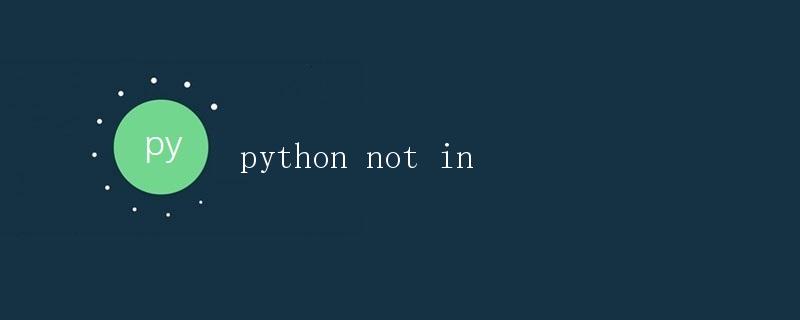Python中的not in运算符详解

在Python中,not in运算符用于检查某个元素是否不在某个序列中,例如列表、元组、字符串等。not in运算符返回一个布尔值,如果指定的元素不在序列中,则返回True,否则返回False。
语法
not in运算符的语法如下所示:
element not in sequence
其中,element为要检查的元素,sequence为要检查的序列。
示例
下面我们通过一些示例来详细解释not in运算符的用法:
检查元素是否不在列表中
# 定义一个列表
fruits = ['apple', 'banana', 'orange', 'grape']
# 使用not in运算符检查元素是否不在列表中
print('apple' not in fruits) # False
print('watermelon' not in fruits) # True
在上面的示例中,我们定义了一个包含水果名称的列表fruits,然后分别使用not in运算符来检查'apple'和'watermelon'是否不在列表中。结果分别为False和True。
检查元素是否不在元组中
# 定义一个元组
colors = ('red', 'green', 'blue', 'yellow')
# 使用not in运算符检查元素是否不在元组中
print('red' not in colors) # False
print('purple' not in colors) # True
在上面的示例中,我们定义了一个包含颜色名称的元组colors,然后分别使用not in运算符来检查'red'和'purple'是否不在元组中。结果分别为False和True。
检查元素是否不在字符串中
# 定义一个字符串
sentence = "Hello, World!"
# 使用not in运算符检查字符是否不在字符串中
print('o' not in sentence) # False
print('x' not in sentence) # True
在上面的示例中,我们定义了一个字符串sentence,然后分别使用not in运算符来检查字符'o'和'x'是否不在字符串中。结果分别为False和True。
检查元素是否不在字典中
# 定义一个字典
person = {'name':'Alice', 'age':30, 'city':'New York'}
# 使用not in运算符检查键是否不在字典中
print('age' not in person) # False
print('gender' not in person) # True
在上面的示例中,我们定义了一个包含个人信息的字典person,然后分别使用not in运算符来检查键'age'和'gender'是否不在字典中。结果分别为False和True。
注意事项
- 当使用not in运算符检查元素是否不在序列中时,可以同时使用if语句来进行条件判断。
# 检查元素是否不在列表中,并进行条件判断
if 'apple' not in fruits:
print('苹果不在水果列表中')
- not in运算符也可以与in运算符搭配使用,对一组元素进行筛选。
# 筛选出不在列表中的水果
new_fruits = ['apple', 'banana', 'orange', 'grape', 'watermelon']
unwanted_fruits = ['apple', 'banana']
filtered_fruits = [fruit for fruit in new_fruits if fruit not in unwanted_fruits]
print(filtered_fruits) # ['orange', 'grape', 'watermelon']
总结:通过本文我们了解了Python中not in运算符的用法及示例,希期可以帮助大家更好地理解和使用这一功能。
 极客教程
极客教程